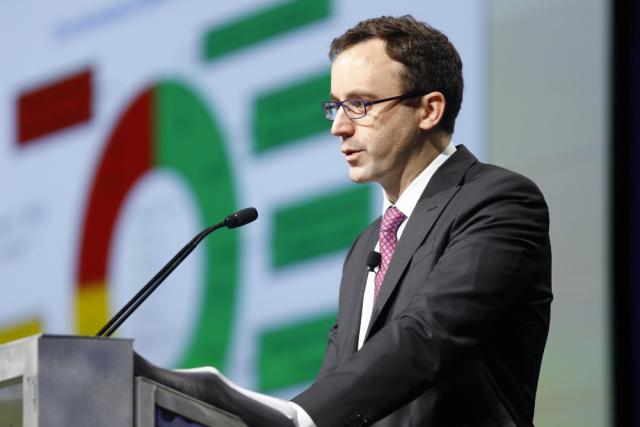
Ryan Keys, co-founder of Triple Crown Resources LLC, airs grievances April 16 during Hart Energy’s DUG Permian Conference and Exhibition in Fort Worth, Texas. (Source: Tom Fox/Hart Energy)
FORT WORTH, Texas—Ryan Keys, co-founder of Midland Basin operator Triple Crown Resources, channeled his inner Frank Costanza during Hart Energy’s DUG Permian Conference and Exhibition.
Like the Seinfield character sitting at his Festivus pole, Keys declared April 16 his Festivus and aired a list of grievances involving the oil and gas industry.
“At the root of these grievances is the current sentiment from the outside world and why we’re seen as a bit of a pariah in the investment community,” Keys told conference attendees. The intent, he said, was not to point fingers but to share lessons. “There are things we’ve done well but concentrating on those won’t make us better.”
The industry has not been Wall Street’s favorite lately, despite companies becoming more efficient, using technology and spending on economic wells, working to add value for shareholders.
Keys framed his list with the introduction of Permian Co., a combination of 13 pure-play Permian public companies. Altogether, Permian Co. boasts of 3 million acres in the Delaware and Midland basins with 1.6 million barrels of oil equivalent per day (boe) of production. “At the same premium as Anadarko, this company would represent a $145 billion dollar deal, plus or minus $5 billion,” he said.
But Permian Co. has sold off more than 30% despite growing production 30%, Keys explained, sharing one of his grievances—“the investing public.”
Negative free cash flows don’t help.
The Institute for Energy Economics and Financial Analysis (IEEFA) pointed out in a March report that 2018 was expected to be a turnaround year for America’s fracking industry. As oil prices improved amid record-setting production, the shale industry was expected to produce cash. But that didn’t happen for the most part. Showing lost patience, investors responded by pulling back on the amount of equity and debt financing, according to the report. Norway’s sovereign wealth fund opted to divest from oil and gas E&P companies.
“A healthy industry would generate enough cash not only to sustain its own capital spending, but also to pay off debt and reward stockholders—all while maintaining or even increasing its output to support rising stock prices,” IEEFA said in the report. “Until fracking companies can demonstrate that they can produce cash as well as hydrocarbons, cautious investors would be wise to view the fracking sector as a speculative enterprise with weak and uncertain fundamentals.”
The industry has not communicated its message well to the generalist investor, according to Keys.
“We’re not telling in it a way a generalist or a layman can understand. So I think we need to get back to the very, very basics and communicate why Joe Investor’s energy stock is going to go up and to the right.”
Explain “how foundational our product is” and how “this boe enables basically life as we know it,” Keys said. “I think if we concentrated more on connecting how our investors’ lives are affected and improved by this boe, maybe less on a normalized 30-day IP,” perhaps they’d pay more attention to the Permian Co. sales pitch.
In other words, tell investors about how much a barrel of oil equivalent can yield in plastics, electricity for an average home, or miles traveled for a car or passenger plane. Restricting capital to one of the few areas in the world with oil supply growth might worsen standards of living, he added.
VIDEO: DUG Permian 2019 Producer Panel - Triple Crown Resources Co-founder Ryan Keys
But there is still room for improvement in terms of cost structure.
Also on Keys’ list is the industry’s inability to articulate the Permian value proposition and cost structure. This involves explaining to investors that if commodity prices are flat and production grows, then costs will shrink in areas such as lease operating expenses, gathering and transportation, and general and administrative (G&A), ultimately increasing margin. But that is only if infrastructure and the organization are designed to actual scale, Keys said.
“What we tell investors is that our cost structure can and should improve because our production and revenue should grow faster than those costs. Things like centralized compression and automation are large investments but the expense savings offers fairly quick payouts at that sufficient scale,” Keys said. “On the G&A front that’s a much bigger deal right now than it was even a year ago. Growing headcount proportionally with rig count won’t offer that scalability. This means we have to be efficient at work.”
However, free cash flow is considered investors’ top complaint with the industry.
“Combined, Permian Co. spent about $2 billion more than it told investors that it would. So maybe there’s a bit of a trust issue here,” Keys said. Both D&C and infrastructure exceeded guidance.
He pointed out that at about $5,000 per acre fully built out infrastructure will lower full-cycle costs, and investors love hearing about this. “They like hearing about how a small water investment can remove a nickel and dime off the boe operating expense,” he said. “Maybe if we talk more about that …and about what we want to build this year then we’d create more alignment between them, ourselves, our asset, our cash margins and our people—showing that the full-cycle economics of our assets work really nicely if they’re patient and allow us to build that scale.
“Ultimately investors are looking for yield now much more than growth and Permian Co. had negative 5% free cash flow last year,” Keys added.
Another grievance: breakeven economics are misleading, according to Keys.
“NPV 10 breakeven is really useful for benchmarking and capital allocation. But I think we should leave it there and not let it get into investor materials,” Keys said. “There is nothing about a well that has a half cycle rate of return of 10% that is breakeven. … A 10% rate of return well certainly does not make the equity break even. So when they [investors] hear a $30 breakeven and then see how the stock does … I can imagine that might be confusing.”
Also on Keys’ list of grievances was that energy companies spend too much on energy, shelling out more in D&C fuel costs for diesel engines when less expensive gas turbines and electric motors are available.
He also called the oft-used term “world-class reservoir” misleading. “I think this phrase diminishes what each and every one of you has accomplished in the last half decade,” he said. “It was ingenuity and a lot of hard work, not rock quality.”
Velda Addison can be reached at vaddison@hartenergy.com.
Recommended Reading
TotalEnergies Acquires Eagle Ford Interest, Ups Texas NatGas Production
2024-04-08 - TotalEnergies’ 20% interest in the Eagle Ford’s Dorado Field will increase its natural gas production in Texas by 50 MMcf/d in 2024.
Chevron Hunts Upside for Oil Recovery, D&C Savings with Permian Pilots
2024-02-06 - New techniques and technologies being piloted by Chevron in the Permian Basin are improving drilling and completed cycle times. Executives at the California-based major hope to eventually improve overall resource recovery from its shale portfolio.
Proven Volumes at Aramco’s Jafurah Field Jump on New Booking Approach
2024-02-27 - Aramco’s addition of 15 Tcf of gas and 2 Bbbl of condensate brings Jafurah’s proven reserves up to 229 Tcf of gas and 75 Bbbl of condensate.
CEO: Continental Adds Midland Basin Acreage, Explores Woodford, Barnett
2024-04-11 - Continental Resources is adding leases in Midland and Ector counties, Texas, as the private E&P hunts for drilling locations to explore. Continental is also testing deeper Barnett and Woodford intervals across its Permian footprint, CEO Doug Lawler said in an exclusive interview.
US Gas Rig Count Falls to Lowest Since January 2022
2024-03-22 - The combined oil and gas rig count, an early indicator of future output, fell by five to 624 in the week to March 22.





